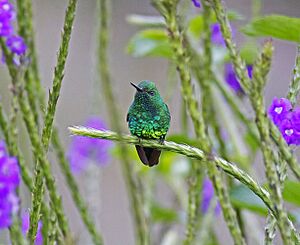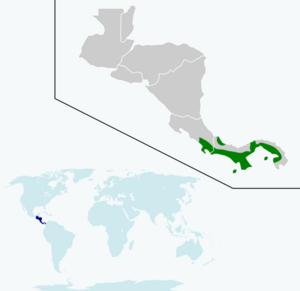Garden emerald facts for kids
Quick facts for kids Garden emerald |
|
|---|---|
 |
|
| Resting on a blue porterweed | |
| Conservation status | |
| Scientific classification | |
| Genus: |
Chlorostilbon
|
| Species: |
assimilis
|
 |
|
The garden emerald (Chlorostilbon assimilis) is a tiny, sparkling hummingbird. It belongs to a group of hummingbirds called "emeralds." You can find this beautiful bird in Costa Rica and Panama.
Contents
About the Garden Emerald's Family
Long ago, some scientists thought the garden emerald was just a type of blue-tailed emerald. But now, they agree it's its own special species. It's called monotypic, which means it's the only bird in its specific group (or 'species') that doesn't have any subspecies (smaller groups within the species).
What Does the Garden Emerald Look Like?
The garden emerald is a small bird, about 7.8 to 8.5 centimeters (3 to 3.3 inches) long. It weighs around 3 to 4.1 grams (0.11 to 0.14 ounces).
Male Garden Emeralds
Adult male garden emeralds have dark, shiny green feathers on their upper bodies. Their tail feathers are a pretty bluish green. Their tails are forked, like a swallow's, and are blue-black. The feathers in the middle of the tail have a slight bluish green shine. Their undersides are a brighter, shinier green, sometimes with a light blue glow. They also have white fluffy feathers on their thighs.
Female Garden Emeralds
Adult female garden emeralds have bright, shiny green to bronze-green feathers on their upper bodies. Their tail feathers are also bluish green. Their tails are blue-black, but the central feathers are dull metallic green. The outer tail feathers have pale gray tips. Females have dusky (darkish) cheeks and a white or grayish-white spot behind their eyes. Their undersides are pale gray.
Young Garden Emeralds
Young male garden emeralds look a lot like the adult females. However, their undersides are a darker gray.
Where Do Garden Emeralds Live?
You can find the garden emerald in southwestern Costa Rica and along the Pacific coast of Panama. They also live on islands off the coast, like Coiba and the Pearl Islands.
These hummingbirds like open areas. They live at the edges of forests, in hedgerows (rows of bushes), and near streams. You can also spot them in scrublands (areas with small trees and bushes) and even in gardens! They prefer low-lying areas, from sea level up to about 1500 meters (4900 feet) in Costa Rica and 1200 meters (3900 feet) in Panama.
How Do Garden Emeralds Behave?
Movement
Garden emeralds usually stay in one place. They don't travel far. However, there have been reports of them moving between mainland Panama and the Pearl Islands, as well as other small islands nearby.
Feeding Habits
The garden emerald eats nectar from flowers. It flies along a regular path, visiting a circuit of flowering trees, shrubs, and other plants. This way of feeding is called "trap-lining." They also eat small insects, which they pick off plants.
Reproduction and Life Cycle
Scientists don't know everything about the garden emerald's breeding season. In Panama, it seems to happen from November to March. We don't have many details about their nests, how long their eggs take to hatch, or when the young birds leave the nest. However, it's thought that their breeding habits are similar to other hummingbirds in the Chlorostilbon group.
Vocalization
The sounds the garden emerald makes are not very well known. They seem to sound similar to the Canivet's emerald (Cynanthus canivetii). The song of that species is described as a "wiry tseee tseeree" sound that is repeated over and over. Their call is a dry, scratchy "chut" or "chit," sometimes sounding like a soft, quick chatter.
Conservation Status
The IUCN (International Union for Conservation of Nature) has listed the garden emerald as a species of "Least Concern." This means they are not currently in danger of disappearing. They live across a large area, and their population is estimated to be at least 50,000 adult birds. This number is believed to be stable.
No immediate threats have been found for the garden emerald. They are quite happy living in places changed by humans, like gardens. They might even be spreading to new areas as forests are cleared.
Images for kids




